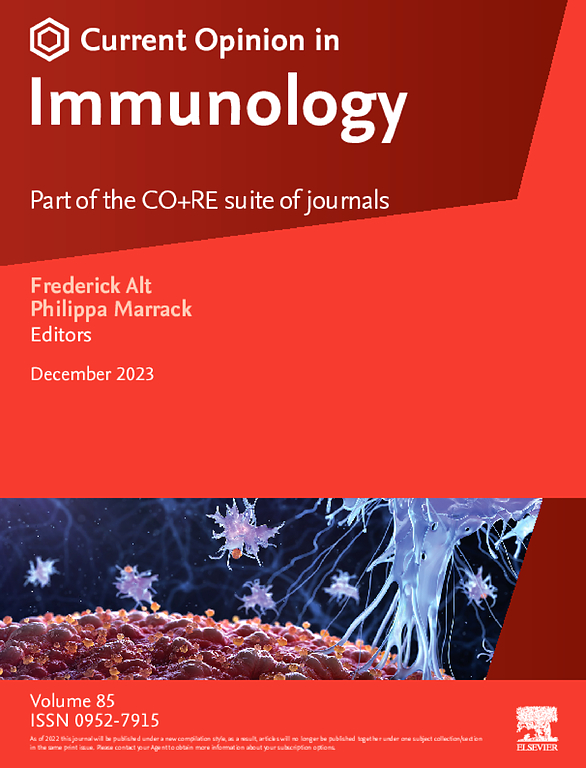Can juvenile idiopathic arthritis be cured?
IF 5.8
2区 医学
Q1 IMMUNOLOGY
引用次数: 0
Abstract
Juvenile idiopathic arthritis (JIA) is the most common rheumatological disorder affecting children. It is characterized by chronic synovial inflammation that may lead to permanent joint damage and disability. JIA is an umbrella term for a heterogenous group of subtypes based on specific clinical and serological features. Each subtype has a multifactorial pathogenesis that involves a complex interplay of genetic susceptibility, environmental triggers, and immune dysregulation. Recent advancements in genomic and multi-omics research have elucidated key genetic and epigenetic contributors to JIA, including risk loci within the highly polymorphic human leukocyte antigen region and monogenic mutations in genes, such as LACC1, UNC13D, and NFIL3. Genome-wide association studies have further revealed that many JIA-associated single-nucleotide polymorphisms (SNPs) reside in noncoding regulatory regions, underscoring the significance of chromatin architecture and transcriptional control in disease development.
While current therapies — including nonsteroidal anti-inflammatory drugs (NSAIDs), disease-modifying antirheumatic drugs (DMARDs), biologics, and corticosteroids — offer symptomatic relief, they do not provide a cure, and many patients experience variable treatment responses or adverse effects. Emerging strategies focus on precision medicine approaches, integrating therapeutic biomarkers to predict disease course and optimize treatment. Furthermore, gene therapy using viral and mRNA-based vectors and advanced cell-based therapies — including regulatory T cells (Tregs), CAR-Tregs, and chimeric autoantibody receptor (CAAR)-T cells — are being explored as potential disease-modifying interventions. These innovative approaches aim to restore immune tolerance, reprogram dysregulated immune pathways, and minimize systemic immunosuppression. Although still in experimental stages, these technologies hold promise for achieving durable remission or potential cure in JIA. Continued translational research and clinical trials will be pivotal in realizing the therapeutic potential of these novel interventions.
青少年特发性关节炎能治愈吗?
幼年特发性关节炎(JIA)是影响儿童的最常见的风湿病。它的特点是慢性滑膜炎症,可导致永久性关节损伤和残疾。JIA是基于特定临床和血清学特征的异质性亚型的总称。每个亚型都有一个多因素的发病机制,涉及遗传易感性、环境触发和免疫失调的复杂相互作用。基因组学和多组学研究的最新进展已经阐明了JIA的关键遗传和表观遗传因素,包括高度多态性的人类白细胞抗原区域内的风险位点和基因的单基因突变,如LACC1、UNC13D和NFIL3。全基因组关联研究进一步揭示了许多与jia相关的单核苷酸多态性(snp)存在于非编码调控区域,强调了染色质结构和转录控制在疾病发展中的重要性。虽然目前的治疗方法——包括非甾体抗炎药(NSAIDs)、改善疾病的抗风湿药(DMARDs)、生物制剂和皮质类固醇——可以缓解症状,但它们不能治愈,而且许多患者经历了不同的治疗反应或不良反应。新兴战略侧重于精准医学方法,整合治疗性生物标志物来预测病程和优化治疗。此外,利用病毒和mrna为载体的基因治疗和先进的细胞治疗——包括调节性T细胞(Tregs)、CAR-Tregs和嵌合自身抗体受体(CAAR)-T细胞——正在被探索作为潜在的疾病改善干预措施。这些创新的方法旨在恢复免疫耐受,重新编程失调的免疫途径,并最大限度地减少全身免疫抑制。尽管仍处于实验阶段,但这些技术有望实现JIA的持久缓解或潜在治愈。持续的转化研究和临床试验将是实现这些新干预措施的治疗潜力的关键。
本文章由计算机程序翻译,如有差异,请以英文原文为准。
求助全文
约1分钟内获得全文
求助全文
来源期刊
CiteScore
13.30
自引率
1.40%
发文量
94
审稿时长
67 days
期刊介绍:
Current Opinion in Immunology aims to stimulate scientifically grounded, interdisciplinary, multi-scale debate and exchange of ideas. It contains polished, concise and timely reviews and opinions, with particular emphasis on those articles published in the past two years. In addition to describing recent trends, the authors are encouraged to give their subjective opinion of the topics discussed.
In Current Opinion in Immunology we help the reader by providing in a systematic manner: 1. The views of experts on current advances in their field in a clear and readable form. 2. Evaluations of the most interesting papers, annotated by experts, from the great wealth of original publications.
Current Opinion in Immunology will serve as an invaluable source of information for researchers, lecturers, teachers, professionals, policy makers and students.
Current Opinion in Immunology builds on Elsevier''s reputation for excellence in scientific publishing and long-standing commitment to communicating reproducible biomedical research targeted at improving human health. It is a companion to the new Gold Open Access journal Current Research in Immunology and is part of the Current Opinion and Research(CO+RE) suite of journals. All CO+RE journals leverage the Current Opinion legacy-of editorial excellence, high-impact, and global reach-to ensure they are a widely read resource that is integral to scientists'' workflow.

 求助内容:
求助内容: 应助结果提醒方式:
应助结果提醒方式:


